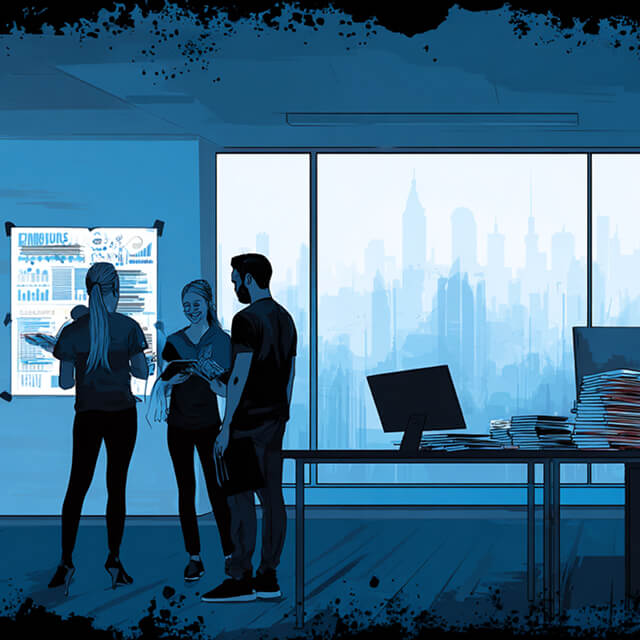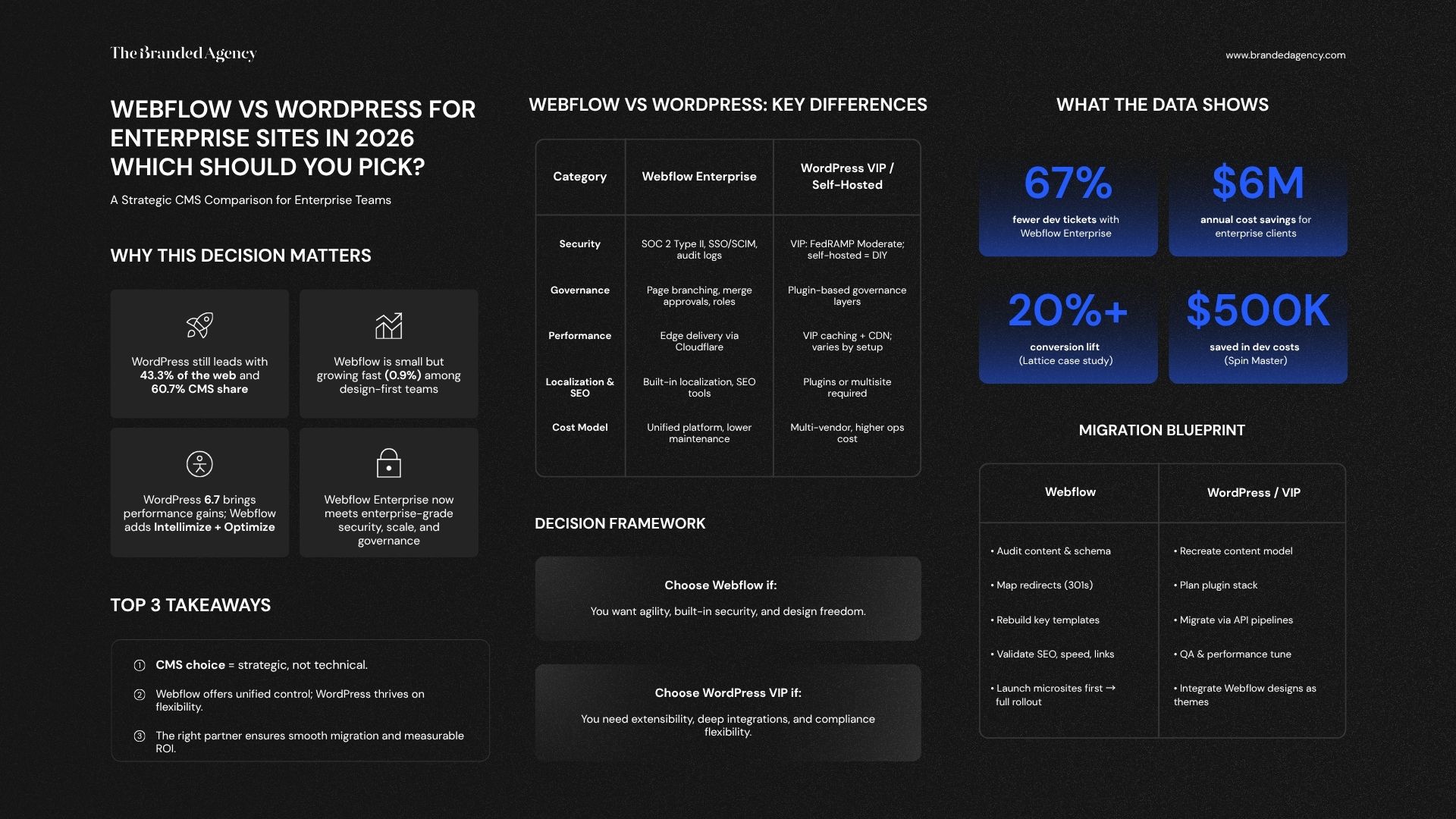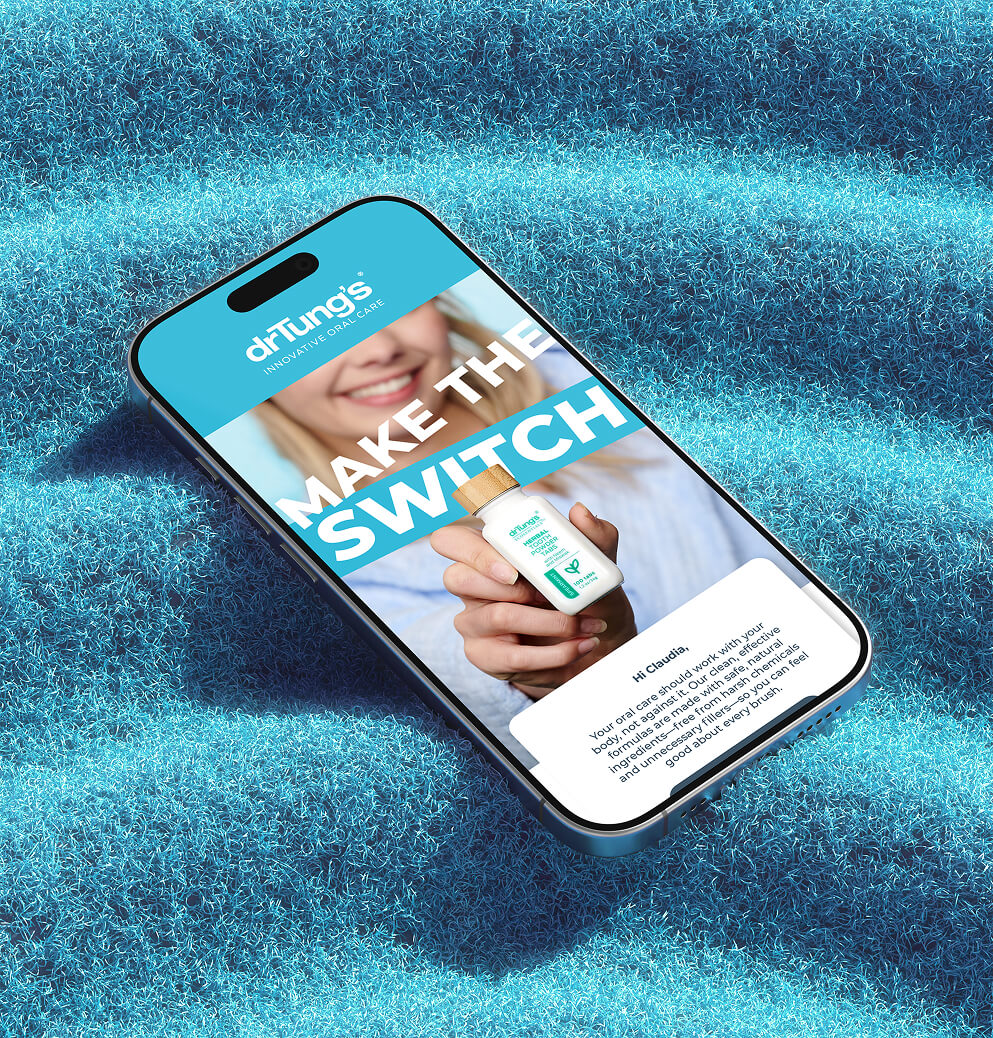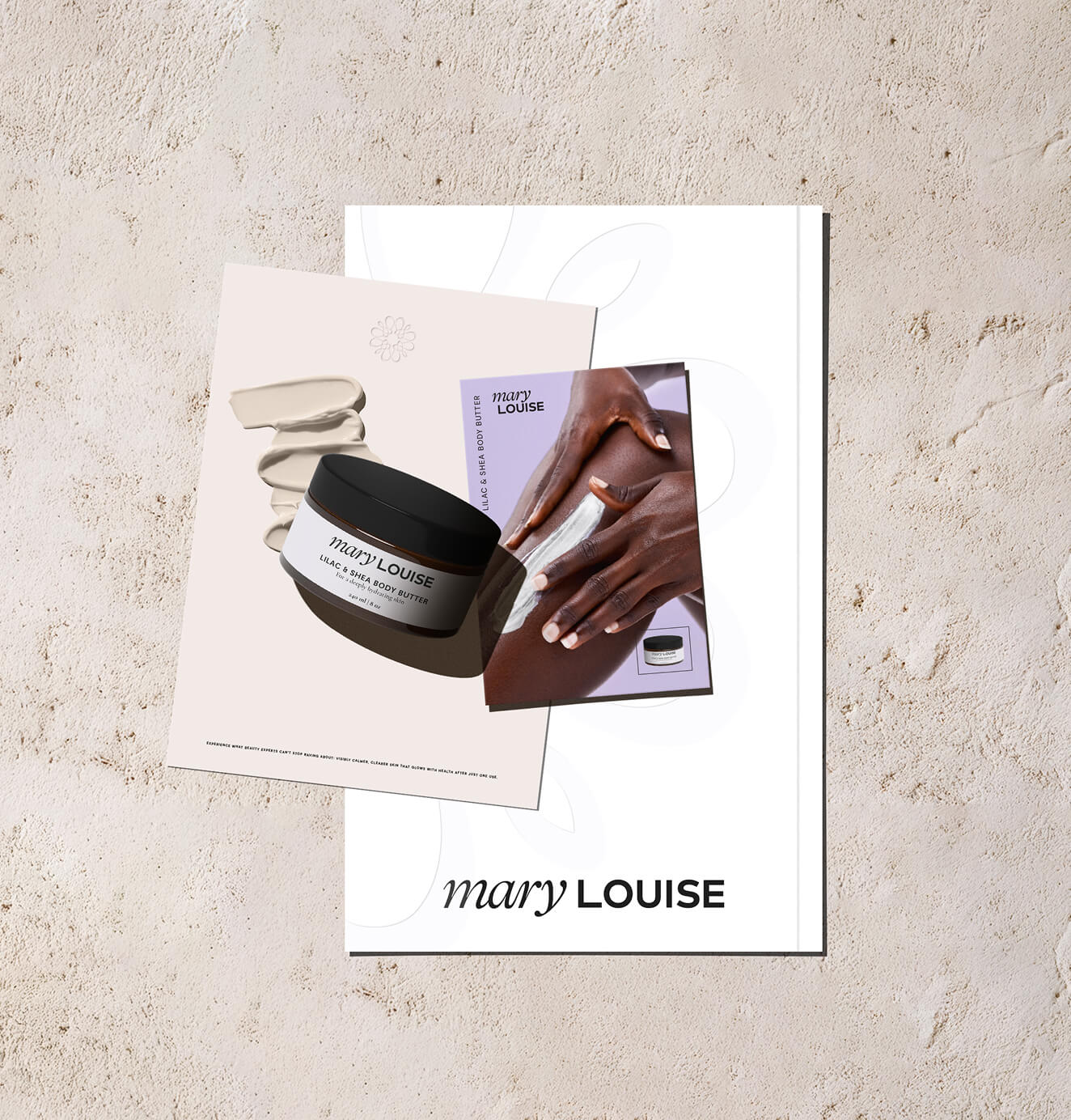Webflow vs WordPress for Enterprise Sites in 2026 Which Should You Pick?
08/21/2025
Web Design / Web Dev
Choosing between Webflow and WordPress in 2026 isn’t just a tech decision—it’s a strategic investment in agility, governance, and enterprise scalability that defines your brand’s digital future.

In 2026, choosing a CMS for your enterprise website is more strategic than ever. You must balance agility, governance, scale, localization, and cost.



Why This Decision Matters Now



As an Enterprise Webflow Certified Partner, Branded Agency has architected solutions for organizations with complex needs and we’ve learned what works and what doesn’t. In this guide, we’ll walk you through:
- Why this decision is crucial now
- Deep comparisons of Webflow (Enterprise) vs WordPress (VIP + self-hosted)
- Frameworks for your decision (with scoring)
- Real migration tactics
- Sample use cases & proof
- How to choose a partner (and why Branded Agency is a strong fit)
Webflow vs WordPress: Side-by-Side (with Depth)
Security & Compliance
- Webflow: SOC 2 Type II, SSO/SCIM, audit logs, DDoS protections
- WordPress VIP: FedRAMP Moderate, 99.95% SLA
- WordPress self-hosted: flexible, but demands vigilant security practices
Governance & Collaboration
- Webflow: page branching, merge approvals, granular roles
- WordPress: built roles + VIP governance layers, but plugin ecosystem adds complexity
Performance & Hosting
- Webflow: edge delivery via Cloudflare (~98% static assets)
- WordPress VIP: enterprise caching + CDN
- WordPress self-hosted: flexible, but you must architect it
Localization & SEO
- Webflow: native localization with SEO tools, per-locale control
- WordPress: via plugins or multisite / translation layers
Personalization & Testing
- Webflow: native Optimize for A/B & personalization
- WordPress: add external tools (Optimizely, VWO, etc.)
Extensibility / Headless
- Webflow: DevLink, CMS APIs, component import/export
- WordPress: REST / GraphQL + vast plugin ecosystem
Content Scale
- Webflow: Enterprise lifts CMS caps to custom levels
- WordPress: no inherent caps; scaling depends on architecture
Cost & Operational Model
- Webflow: unified platform, fewer vendors
- WordPress: componentized platform + plugin + dev + maintenance
Decision Framework: How to Choose












Use this weighted scoring table (example):

Result Interpretation:
- If Webflow’s total > WP by 10+ → go Webflow
- If WP (VIP) wins by 10+ → go VIP
- If close, pilot smaller domains/pages (microsites) first
Your final choice will often depend on team structure, regulatory needs, and future growth bets (localization, personalization, content scale).
Want to learn more about Website Design, Development and E-commerce? Keep reading!
If you need help with your company’s website and development, contact us for a free custom quote.
Migration & Rollout Strategy

To Webflow (from WordPress or other CMS):
- Audit content + media (identify redundant pages, orphan content)
- Define Webflow CMS schema (collections, fields, references)
- Map URL redirects and 301s to preserve SEO equity
- Rebuild critical templates in Webflow reliably
- Use DevLink / component export for UI parity with existing codebases
- Validate SEO (canonical, hreflang), performance, links
- Launch gradually (e.g. microsites first), monitor, roll into main site
To WordPress / VIP (from Webflow):
- Recreate content model (CPTs, taxonomies) → mirror Webflow schema
- Plan plugin stack (localization, SSO, analytics, cache)
- Migrate content via APIs/export pipelines
- Integrate existing Webflow designs as theme/templates
- Performance tuning & QA at scale
Throughout, use feature flags, staging environments, and rollback plans so you can revert changes if needed.
Use Cases & Results (Proof in the Pudding)
- Webflow’s own marketing page cites “67% decrease in dev ticketing,” “$6M cost savings annually,” “+20% conversion uplift” for enterprise customers. Webflow
- Many enterprises (Discord, Dell, Dropbox Sign) use Webflow to launch high-velocity marketing pages, blogs, and campaign microsites with less friction. paddlecreative.co.uk
- From third-party reporting: Lattice saw ~20% conversion lift; Spin Master claimed $500,000 in dev cost savings using Webflow Enterprise. flareAI
- Webflow customer stories (e.g. agencies like Refokus) report delivering faster iterations, cost savings, and more empowered marketing teams. Webflow
These are real numbers you can discuss in your content and client conversations.
How to Work with Branded Agency
Our approach (high level):
- Discovery & Fit Audit: we assess your current stack, content, governance, and pain points.
- Platform Strategy & Roadmap: pick modular domains or microsite pilots, plan governance, define flavor differences across markets.
- Implementation: build the core templates, branching workflows, localization, DevLink components, and integrations (CRM, analytics, personalization).
- Training & Enablement: train your in-house team on Webflow best practices, audits, and editing workflows.
- Post-Launch Optimization: A/B testing, iteration, support.
Why partner with us:
- We’re Enterprise Webflow Certified, giving you technical confidence and early access.
- We design for scalability & maintainability, avoiding fragility.
- We’ve executed complex migrations and governance builds.
- We back our work with service SLAs, ongoing support, and accountability.
Next steps (for you):
- Start with a Site Audit & Platform Recommendation workshop (1–2 weeks)
- Choose a pilot domain (e.g. blog or campaign site) to validate before full migration
Adopt ongoing roadmap (localization, personalization, content scale)

Frequently Asked Questions (FAQs)

At the end of the day, your CMS should feel like a growth enabler, not a bottleneck. With Webflow (done right) and a team like Branded Agency, you can move faster, stay secure, and scale your digital footprint confidently.
1. How does choosing a CMS affect my brand’s consistency?
Your CMS is the backbone of your digital brand. Platforms like Webflow give design and marketing teams more direct control—allowing you to maintain visual and messaging consistency across global markets without waiting on developers.
2. Can Webflow strengthen our brand storytelling compared to WordPress?
Yes. Webflow’s visual canvas and component system make it easier to bring your brand’s story to life through dynamic layouts, motion, and interactive design—without heavy reliance on plugins or code.
3. How do enterprises maintain brand governance across teams and regions?
Webflow Enterprise includes granular roles, page branching, and merge approvals—so design systems and brand elements stay protected, even when multiple teams collaborate across markets.
4. Which platform supports faster brand launches or campaign rollouts?
Webflow’s all-in-one infrastructure enables marketing teams to launch branded microsites and campaigns quickly—ideal for product launches or seasonal storytelling—while WordPress often requires dev coordination for each new rollout.
5. Can Webflow scale with a growing brand and evolving identity?
Yes. Webflow’s CMS is flexible enough to evolve with your content and brand design systems. As your visual identity changes, your team can update reusable components across hundreds of pages without breaking design integrity.
6. How does Webflow handle brand localization and international storytelling?
Its built-in localization tools let you tailor visuals, copy, and SEO by region—so your brand feels local everywhere, without compromising design standards.
7. What role does Branded Agency play in maintaining brand consistency post-migration?
We don’t just migrate your site—we architect systems for brand governance. That includes global style guides, design systems, and scalable templates that keep your identity intact across all future pages, teams, and regions.

Quincy Samycia
As entrepreneurs, they’ve built and scaled their own ventures from zero to millions. They’ve been in the trenches, navigating the chaos of high-growth phases, making the hard calls, and learning firsthand what actually moves the needle. That’s what makes us different—we don’t just “consult,” we know what it takes because we’ve done it ourselves.
Want to learn more about brand platform?
If you need help with your companies brand strategy and identity, contact us for a free custom quote.
We do great work. And get great results.
+2.3xIncrease in revenue YoY
+126%Increase in repurchase rate YoY








+93%Revenue growth in first 90 days
+144% Increase in attributed revenue








+91%Increase in conversion rate
+46%Increase in AOV








+200%Increase in conversion rate
+688%Increase in attributed revenue












